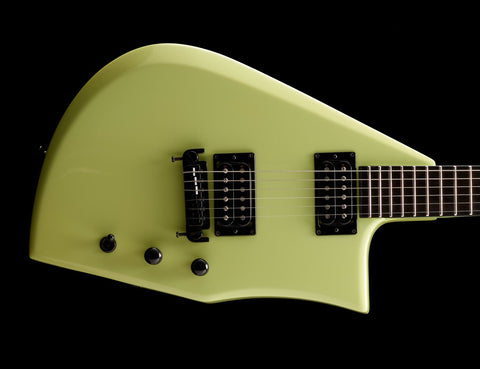A brief summary of the Tool JL edition
One summer day in 1989, I was asked by a good friend and industrial designer about a wish he had to make a completely new guitar model in a modern minimalistic design that would not reflect the old and conservative approach to what an electric guitar should look like. The shape of the electric guitar had been very conservative and the development in terms of its form and design had been largely the same for more than 50 years, with new models following common rules of shape - often with small changes with some exceptions, successful and less successful.
A cut-out shaped masonite board was the draft and topic of conversation at Sjöstugan in Gustavsberg on that summer day of 1989.
The production and standard of the electric guitar had hitherto been characterized by Les Paul's designs from 1952 and Leo Fender’s Telecaster (1948) and Stratocaster (1954).
An unbelievable successful industrial design was now ready for some change and replicas had been copied over and over in absurdity- and still are.
I accepted Jonas Lindkvist's question about assisting in creating the new guitar with the requirement that only if my friend and colleague Arne Arvidsson was allowed to participate in the project - .It was a guarantee of first-class craftsmanship, and that it would work 100% as an instrument for guitarists with the best possible playability.
The first edition of the '90s was made in California and was shown under the brand name "the Sutter" and was shown at the leading exhibition for the music industry - NAMM in LA Ca. It was met with little success, and the guitar was put in mothballs until at the same show in Los Angeles about 15 years later when Robert Moog showed a similar guitar design (Robert Moog was the creator of the synthesizer MOOG).
My close friend Richard Keldsen at the SAGA musical Instruments in San Francisco then told me when he saw this MOOG version appear on NAMM show
Hey Mats, isn 't it time to pick up Jonas' guitar again?
Then I went home, contacted Jonas and Arne, and we started working on the 2nd edition that you see today, with softer lines, and other more timeless microphones, including an improvement in a number of user details.We then worked with Made in Sweden as a motto, and it became a series of 6 (7 with working copies), one of each color.
The mission was to make a modern guitar with unique balance - playability & tone.Because there was tone and sustain in it even without the electronics. A key factor was choosing the right type of wood and what kind of wood there should be in different parts of the guitar.
The first copy from that series went to the American guitarist David Lindley.
During the production in Arne Arvidsson's workshop, Arne made a meticulous drawing and prototype which was realized in a CAD computerized drawing. In every detail and hundredth percent was inspected and tested by Arne and me and finally after a long process we got a prototype that worked.out the way we wanted

For Sweden and electric guitars, we were the first with the process of making a CAD drawing for a guitar production, which at that time was very complex to transfer from drawing to a data file that in practice would allow production at any guitar factory in the world.
At the Frankfurt Trade Fair in Germany around 2014, a leading manufacturer of guitars in the music industry showed interest in starting production and manufacturing the Tool JL in series production. The guitar had now been named the Tool JL after Jonas Lindkvist initials.
The series-produced one model was also approved by Arne Arvidsson, which made me very happy.Our collaboration started in the late '70s and we followed each other until this spring with our mission of guitars - Arne passed away in the autumn of 2020.

Arne Arvidsson was a master and completely unsurpassed when it came to electric guitars and construction and had an understanding of all aspects of manufacturing and function and use.
Arne possessed holistic knowledge in guitar construction and knew the process like no other.
Jonas Lindkvist's unique minimalistic design in the late 1980s and the slow development together with me and Arne became a reality.
The music - that, you have to create by yourself.
Stockholm 2021


